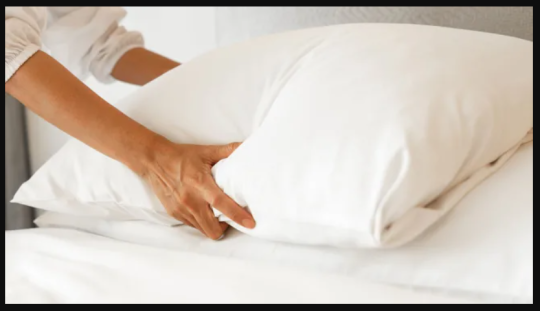Experts say to fluff your pillow every day and wash it four times a year

While you’re probably in the habit of regularly washing your sheets and pillowcases, you might not pay as much attention to what lies beneath - your pillows and mattress. But both need deep cleaning at least twice a year.
“Over time, hair, dead skin cells, sweat, and drool build up on the pillow,” says Neil Kao, MD, an allergist-immunologist in Greenville, S.C. And all that gunk is basically the stuff that dust mites love to munch on, which causes their population to multiply and increases your chances of having an allergic reaction to their presence.
Along with washing your pillow a few times a year - you might also want to invest in a pillow protector to keep a lot of the gross stuff out and extend the life of your pillow.
In this article - the steps of how to keep your pillow fresh, clean, and ready for a good night’s sleep.
Just one thing before you clean: When washing pillows, always read the label first. Many pillows—though not all—can be machine washed.
Step 1: Air It Out
Give your pillows daily fluffing to restore their shape and remove dust. Then, every month or so, hang them outdoors on a clothesline for a few hours, ideally on a bright, breezy day. If that’s not an option, as with some foam and latex pillows, run them through the dryer on the no-heat cycle.
Step 2: Wash It Gently
“If your pillow can withstand being laundered, you should wash it at least twice a year, or quarterly if you sweat a lot, eat in bed, or have pets sleep in your bed with you,” says Melissa Homer, a chief cleaning officer at MaidPro, a housecleaning franchise in the United States and Canada.
Laundering a pillow isn’t difficult, though it can take a bit of time to dry.
If your pillow has a wet stain that you’re trying to remove, spot treat the pillowcase and pillow with a stain cleaner that targets that type of stain before popping it into the wash. (The same trick works for getting stains out of a mattress.)
If your washing machine is large enough, wash two pillows at a time. That will help balance the load, allowing the water and detergent to circulate more effectively. Because the agitator on conventional top-loaders can be tough on pillows, it’s best to agitate on the gentle cycle only for a few minutes (or the shortest possible setting, if you can’t control the time).
Alternatively, you could make a special trip to the laundromat to use its front-loaders.
Follow these directions for specific types of pillow fills:
• Down or feather: Most down pillows can be put in the washing machine. But use cool water and a mild detergent, then dry on low heat. (High temperatures can damage the down.)
• Memory foam or latex: Washer agitation can break up foam, so these pillows will probably need to be hand-washed. Vacuum dust off of the pillow, then spot clean with a damp cloth and a small amount of mild detergent. Lay the pillow flat to air dry.
• Polyester: Wash with warm water on the gentle cycle, preferably a few pillows at a time to balance the load. Be sparing with the detergent—use about 1 tablespoon of liquid soap.
• Buckwheat hulls: Empty the buckwheat filling onto a large cookie sheet or wide, shallow bowl. Set the buckwheat out in the sun, which will eliminate odours, and wash the shell casing using cold water and a mild detergent.
Step 3: Dry It Thoroughly
It’s crucial to get the pillow completely dry—otherwise, you risk mildew. Skip the auto-dry setting on your clothes dryer, because the sensors will detect only surface moisture, leaving you with a pillow that’s still damp on the inside.
Instead, many pillows can be dried for a good hour on moderate heat. Adding a couple of dry towels will speed things up. Toss in two fresh tennis balls or dryer balls and they’ll keep the filling from clumping as they bounce around the drum.
When drying down or feather pillows, however, use the no-heat air-dry setting (it will take a while) and dryer balls or tennis balls to break up clumps.
If the weather is mild, you can hang most pillows on the clothesline until they’re dried all the way through. Whichever drying technique you use, you still need to check for moisture inside the pillow. If none remains, it’s time to make the bed.
It is recommended to use pillow covers to protect pillows from substances such as sweat, body oils, and face cream. Launder both the pillow cover and the pillowcase regularly—say, once a week—along with your sheets. If you need pillow protectors - we recommend taking a look at the great range offered by Bed King.
.
.
.
Info sourced from https://www.consumerreports.org/
No comments:
Post a Comment